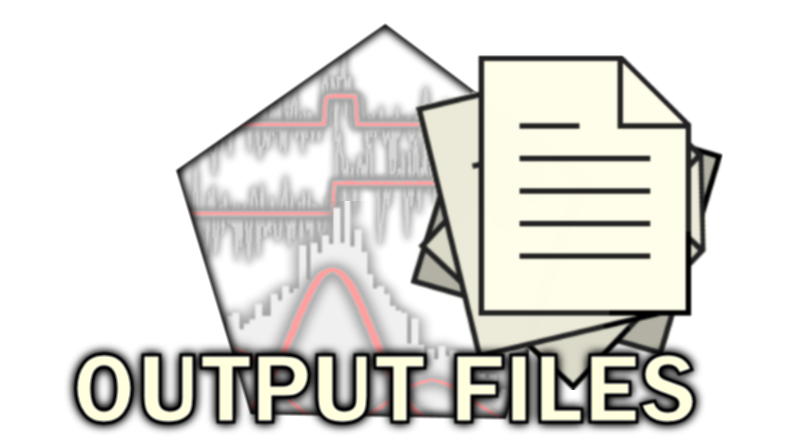
State population files from Histogram analysis
State population files are ASCII files with the extension .txt. They are usually found in the main/histogram_analysis folder.
Table of contents
Description
State population files are data-specific and contain methods, parameters and results of state population analysis.
They are created in the /histogram_analysis analysis sub-folder after state population analysis and when exporting results from the
Project management area of module Histogram analysis.
File name
The file is named by the user during the export process.
By default, the file is named after the project file loaded in Histogram analysis, and is appended with an extension depending on the Method settings:
_[Ddd]_gaussif populations are calculated with Gaussian fitting, where[Ddd]is the data type written in the file_[Ddd]_threshif populations are calculated with thresholding
Data types supported in state population files are:
I[i]-[L]: intensities in detection channel indexed[i]upon illumination with laser wavelength[L]nmtotal[i]-[L]: summed intensities upon illumination with laser wavelength[L]nm (donor in detection channel indexed[i]in absence of acceptor)FRET[D]to[A]: FRET from donor emitter detected in channel indexed[D]to acceptor emitter detected in channel indexed[A]S[D]to[A]: stoichiometry associated to donor emitter detected in channel indexed[D]and acceptor emitter detected in channel indexed[A]
The data type is appended with a first extension _[Ttt] if a particular subgroup of molecules was analyzed, with [Ttt] the corresponding molecule tag.
A second extension _discr is added when state populations determined from state trajectories are written in the file.
Structure
Method settings
The first lines in file are dedicated to the method settings and depends on how populations are calculated.
For population calculated with thresholding, threshold positions and limits of each state populations are given such as:
Thresholds:
- population [j]: from [...] to [...]
with [j] the state index.
For population calculated with Gaussian fitting, the fitting equation and starting fit parameters are given such as:
Fitting equation:
Starting fit parameters with FWHM = o * 2*sqrt(2*ln(2)):
- Gaussian [j]: A_[j]=[...] mu_[j]=[...] FWHM_[j]=[...]
with A_[j], mu_[j], FWHM_[j] containing the starting guess for the amplitude, mean and full width at half maximum of the [j]th Gaussian component.
If method settings include BOBA-FRET, bootstrapping parameters are given such as:
Bootstraping parameters:
Analysis results
The next lines contain the results of the state population analysis and depends on how populations are calculated.
For population analysis with thresholds, state relative populations are written at:
Relative occurences:
If method include BOBA-FRET, bootstrap means and standard deviations of relative populations are written instead and at:
Bootstrap mean (relative occurences):
Bootstrap standard deviation (relative occurences):
and relative populations for each bootstrap sample is recorded in a column-wise fashion, such as:
- column
samplecontaining sample indexes - columns
population [j]containing the relative population of state[j]
Bootstrap samples (relative occurences):
sample population 1 population 2 population 3
1 7.213219e-01 1.704264e-01 1.082517e-01
2 6.873816e-01 1.948943e-01 1.177242e-01
3 7.742181e-01 1.596652e-01 6.611676e-02
For population analysis with Gaussian fitting, Gaussian parameters and relative populations from the fit are written in a column-wise fashion with:
- column
Gaussiancontaining the Gaussian components index - columns
A,mu,FWHMcontaining the amplitudes, means and full widths at half maximum of Gaussian components in the mixture - column
relative occurencecontaining the state relative population
Fit parameters:
Gaussian A mu FWHM relative occurence
1 1.748954e-01 -7.565527e-03 7.943746e-02 6.315490e-01
2 1.747060e-02 1.590892e-01 5.012021e-01 3.684510e-01
If method include BOBA-FRET, bootstrap means and standard deviations of Gaussian parameters and relative populations are written instead, such as:
Bootstrap mean:
Gaussian A mu FWHM relative occurence
1 1.742200e-01 -7.892227e-03 7.939498e-02 6.270481e-01
2 1.799302e-02 1.632702e-01 5.146596e-01 3.729519e-01
Bootstrap standard deviation:
Gaussian A mu FWHM relative occurence
1 1.596279e-02 2.501341e-03 4.625068e-03 4.822357e-02
2 3.537184e-03 2.178907e-02 1.126754e-01 4.822357e-02
and fit parameters and relative populations for each bootstrap sample is recorded in a column-wise fashion, such as:
- column
samplecontaining sample indexes - columns
A_[j],mu_[j],FWHM_[j]containing the amplitudes, means and full widths at half maximum of the[j]th Gaussian components in the mixture - columns
relocc_[j]containing the state relative population of the[j]th Gaussian components in the mixture
Bootstrap samples:
sample A_1 mu_1 FWHM_1 relocc_1 A_2 mu_2 FWHM_2 relocc_2
1 1.636259e-01 -4.350341e-03 8.568204e-02 6.282864e-01 1.745914e-02 1.834205e-01 4.978150e-01 3.717136e-01
2 1.618894e-01 -7.044866e-03 8.539515e-02 6.143356e-01 1.440769e-02 2.036760e-01 6.708602e-01 3.856644e-01
3 1.703852e-01 -7.264723e-03 7.297065e-02 5.679364e-01 2.628222e-02 1.760318e-01 3.740112e-01 4.320636e-01